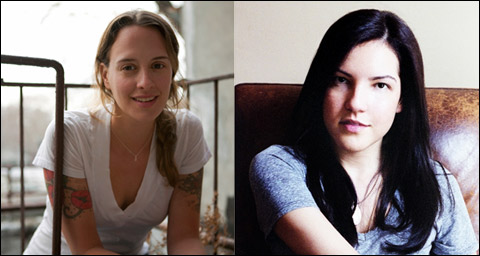Sloane Crosley and Emily Gould tell all
By SHARON STEEL | June 20, 2010

Emily Gould (left) and Sloane Crosley |
There's only one thing more dangerous than being an ambitious, attractive twentysomething female stumbling through the publishing industry, attempting to secure quantifiable career success and, also, a fantastic boyfriend: the impulse to write about it. It's understood yet unspoken that the publication of a memoir that generates some attention is likely to make a writer's life, in a certain sense, unbearable; ultimately, though, her life will probably become worse in ways that are more interesting than it was before. Which is excellent fodder for a second book.How Did You Get This Number | By Sloane Crosley | Riverhead | 288 pages | $25.95 And the Heart Says Whatever | By Emily Gould | Free Press | 224 pages | $16 |
New York writers Sloane Crosley and Emily Gould are equally conscious of this. Each has been anointed or derided, in some form or another, as an ingénue voice of their generation — Generation Y, the one that hasn't grown up cataloguing the glorious and terrible minutiae of their lives on the Internet, but has come into adulthood doing so. Both authors pinpoint moments in their pasts that are at once passionately different yet completely parallel. They are essentially trying to candidly reconcile the same thing — which is how weird and wonderful it is to be young and disappointed in an urban setting rife with competition and countless other fucked-up, good-looking individuals. And specifically to be at an age when you're forced to figure out whether you're suffering because you're good enough to make it eventually, or if the end goal actually is the exquisite torment itself.
And The Heart Says Whatever is Gould's second book (she's also the co-author of a young-adult novel, Hex Education), but her first collection of personal essays. How Did You Get This Number is Crosley's sophomore autobiographical collection and a follow-up to her debut I Was Told There'd Be Cake, a New York Times bestseller that's currently in development as an HBO series. The experience of reading these new volumes is akin to being taken into confidence by two writers who aren't quite sure whether they like themselves very much, but are charmed and amused by the ways in which they don't.
Gould, a former editor at media-and-culture blog Gawker, has the more notorious image. Critics have chastised her for a cutting, heartbreakingly self-aware style that's comparable to an unedited diary entry. In the next breath, they've praised Crosley — whose day job is as a publicist at Random House — for a conversationally intimate, droll playfulness that makes her quirky foibles extremely compelling.
Gould is more outrageous in her sexual confessions, Crosley more reserved. But although the good-girl/bad-girl analogies are as obvious as their different styles, both are writing about the same thing — they're just different people, with backgrounds and back stories that have, in some cases, had too much bearing on the quality of their work. Both have a flair for composing essays that feel like Polaroid photographs, the very kind that Generation Y happens to love. In both cases, this is the sweat of craft posing as artless, tossed-off immediacy. And although their subject matter and style are wholly contemporary, their themes have a deceptively vintage tinge, giving the work an extra layer of meaning — up-to-the-minute observations reflecting age-old concerns.
 Topics
Topics:
Books
, Entertainment, Media, Liz Phair, More  , Entertainment, Media, Liz Phair, Books, Gawker, Book Reviews, Sloane Crosley, Sloane Crosley, Dorothy Parker, Larry David, Less
, Entertainment, Media, Liz Phair, Books, Gawker, Book Reviews, Sloane Crosley, Sloane Crosley, Dorothy Parker, Larry David, Less 